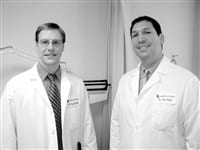Heavy Decisions Bariatric Surgery Is Less Invasive Than Ever — And It’s Catching On
No one who has walked down the street recently can deny what doctors have been warning about for years — Americans are heavier than ever.
Statistics on who’s overweight tend to vary widely, but the American Society for Bariatric Surgery estimates that four million Americans are morbidly obese — more than 100 pounds overweight. And that’s why bariatric surgery — known in some of its forms as gastric bypass — is gaining popularity as quickly as fast-food eaters gain weight.
The treatment gained momentum over the past few years when two well-known celebrities, singer Carnie Wilson and weatherman Al Roker, emerged from bariatric surgery — which sharply limits the volume of the stomach — reporting early success. They also, in many eyes, looked much better for the experience.
But while a swift, dramatic reversal in weight gain may have cosmetic benefits, doctors stress that appearance is the least of their concerns when it comes to America’s rising obesity rates.
For example, a Veterans Administration study of 200 obese men aged 23 to 70 years, with an average weight of 316 pounds, showed a twelve-fold increase in mortality in the 25-to-34 year age group and a six-fold increase in the 35-to-44 year age group.
Meanwhile, the recent Nurses Health Study suggests that women are at risk at lower degrees of obesity. Weight gain after the age of 18 years was shown to be a strong predictor of cardiovascular risk, as was a high BMI.
Obesity is also dangerous because of the associated increased prevalence of hypertension, diabetes, mellitus, hyperinsulinemia, and low levels of HDL cholesterol — all predictors of cardiovascular disease. Cancer mortality rates are also elevated in severely obese females.
The good news is that bariatric surgery is as minimally invasive as ever, as technology and expertise catch up with a weighty problem.
Epidemic Proportions
“Obesity is an epidemic,” said Dr. Viriato M. Fiallo, a surgeon with Pioneer Valley Surgical Associates in Springfield, who performs bariatric surgery along with Dr. Burritt I. Haag. “More and more people are suffering from this problem, there’s a greater awareness of the dangers of being obese, and doctors are treating obesity more aggressively.”
Yet, they’re still being careful who receives this treatment. Doctors say that candidates for the surgery must be 100 pounds overweight with a body-mass index of 40 or more. By comparison, people with numbers over 25 are considered overweight, and 30 or higher signifies obesity. (To determine body-mass index, multiply one’s weight in pounds by 703, then divide by height in inches, and divide by height in inches again.)
Patients with an index figure between 35 and 40 combined with other health risks, such as diabetes or hypertension, also might be surgical candidates, Fiallo said.
And it’s not an end-all treatment, he added. “It should be part of a comprehensive weight loss program. They work with dieticians to teach them how to eat and the appropriate food to eat. Most of the insurance companies also require a psychological evaluation to make sure the patient can cope with the new changes in their lives.”
That is, when insurers cover the procedure at all. Many do not, Haag said, even though the procedure has been around for more than 20 years and is not considered cosmetic by physicians. But that could be changing as more health plans come around.
“Once insurance companies realize this is a medical problem, not a cosmetic problem, and the procedures become more and more popular, they’ll be willing to approve them,” he said.
Strike Up the Band
Bariatric surgery takes many forms, but Fiallo said there’s a difference between some procedures that have been around for many years, such as the Roux-en-Y gastric bypass and vertical banded gastroplasty, and a newer technique called adjustable laparoscopic banding.
The older methods involved open incisions, while today’s bariatric surgery uses laparoscopes to work inside the body through a few small incisions in the abdomen. Many of the common surgical methods are now being performed laparoscopically, and doctors must be careful to determine which is most appropriate, Fiallo said.
“Safety is an issue, as is the amount of weight loss that needs to be achieved to correct medical problems,” he said. “Patient preference is another factor; it’s ultimately up to the patient to decide what they want.”
Gastric banding uses a band around the stomach that may be adjusted by the physician later on — using a needle and a fluid-filled reservoir under the skin — when the rate of weight loss needs to be altered.
“This procedure has been around in Europe for more than 10 years, but it was approved in the U.S. only two or three years ago,” Fiallo said. “The initial study done in America did not have great results, mainly because it was done by groups with little experience in laparoscopy.”
The results are more gradual than with a gastric bypass, he noted. Patients typically lose up to 60{06cf2b9696b159f874511d23dbc893eb1ac83014175ed30550cfff22781411e5} of their excess body fat within a two-year period, while with the bypass, they can lose more than 75{06cf2b9696b159f874511d23dbc893eb1ac83014175ed30550cfff22781411e5} in a year and a half. In addition, the mortality rate on a banding surgery is about 1 in 20,000 — about 100 times safer than the bypass.
There are still some risks, including formation of blood clots in the legs, leakage of fluid into the stomach and bowels, and formation of hernias that can lead to bowel obstruction. In addition, the band could slip, requiring additional surgery.
And, as in any surgery, patients must undergo a comprehensive medical evaluation before the procedure — making sure the cardiac and pulmonary functions are in good enough shape to handle it — as well as very close follow-up after the operation.
Particularly with a gastric bypass, patients need to make sure they’re absorbing enough iron, calcium, and vitamin B12. “The level of these substances needs to be followed for the rest of their lives,” Fiallo said.
But for patients who have a positive outcome, he added, those are small concerns indeed.
Under Their Skin
Meanwhile, there’s good news for bariatric surgery patients who worry about one side effect of the procedure — the development of excess skin below the abdomen.
“When a patient loses large amounts of weight, the skin does not retain its shape, leaving the patient with a large hanging apron of excess skin and fat below the stomach area, otherwise known as a pannus,” said Dr. Ernest Manders, a member of the American Society of Plastic Surgeons, during the group’s recent Plastic Surgery 2003 conference.
He said studies have shown that complications from a panniculectomy — part of the process of ‘body contouring’ — are greatly reduced when it is performed a year after the bariatric surgery. Those complications include wound infections, wound reopening, and the need for return surgery.
“By focusing on patients who undergo a panniculectomy to remove the pannus, we found significantly fewer complications in patients who had the procedure one year after bariatric surgery rather than during the initial surgery,” Manders said.
He suggested that those who waited for the body contouring procedure fared better because they were healthier going into the procedure. Many of the patients he studied had lost about 100 pounds, brought their diabetes under control, reduced their hypertension, and lowered the stress levels on their hearts, making the panniculectomy a much less risky proposition.
“Before bariatric surgery and body contouring, many of my patients were not even able to work. They often did not have good self-images and didn’t participate in life as most of us do,” Manders said. “After a panniculectomy, I’ve seen many patients ready to be employed again, go shopping, and even take care of grandchildren. This surgery isn’t just beauty surgery — it rehabilitates people so they can have a full life.”
Likewise, to thousands of people now considering bariatric surgery, appearance is obviously a factor. But regaining that full life is a bigger one — a full, healthy life.



